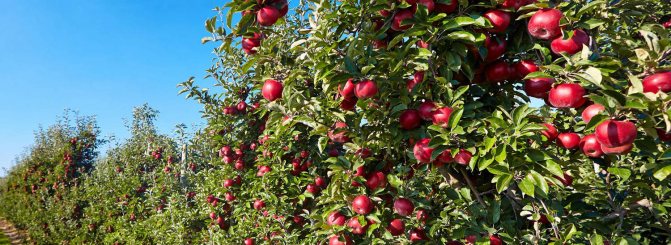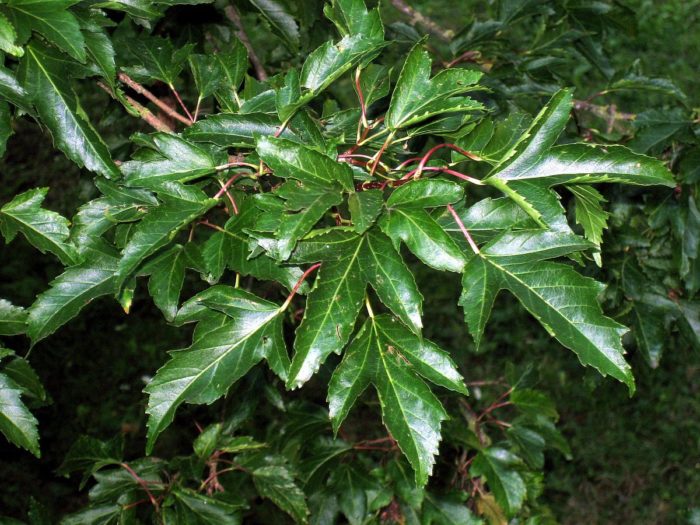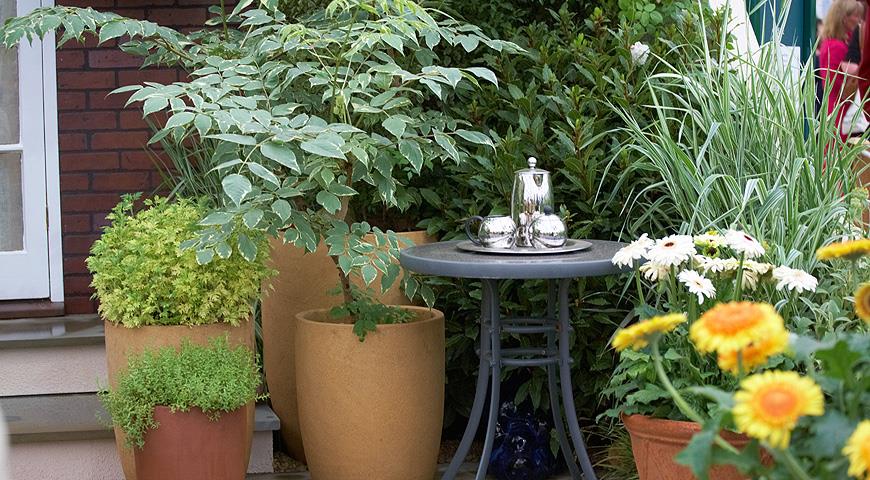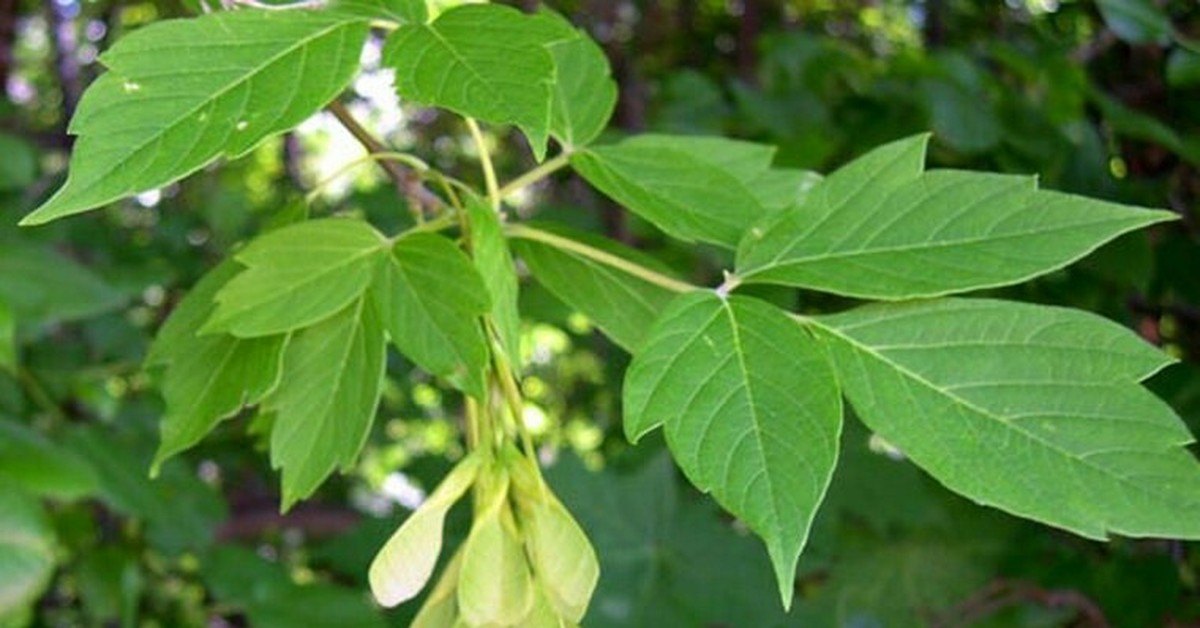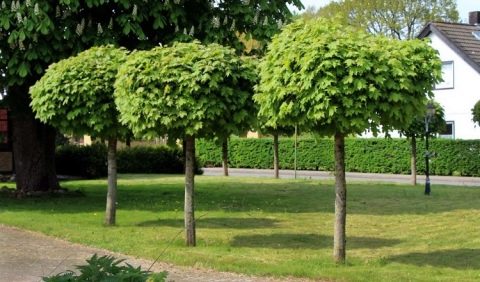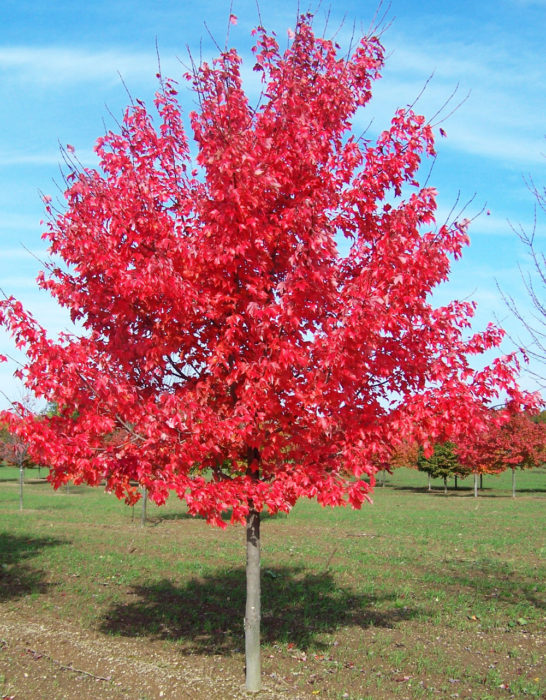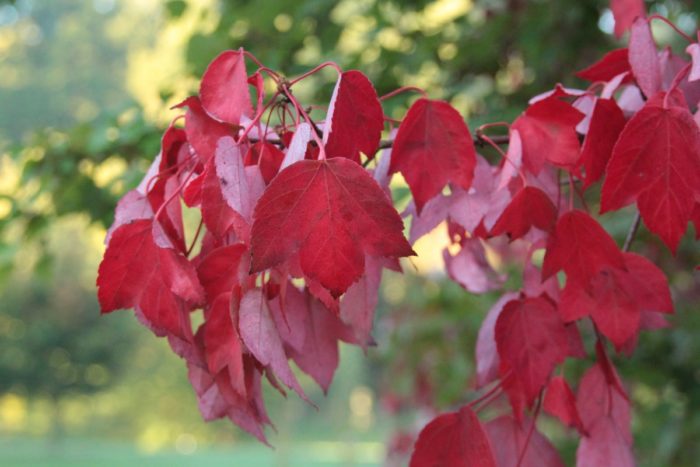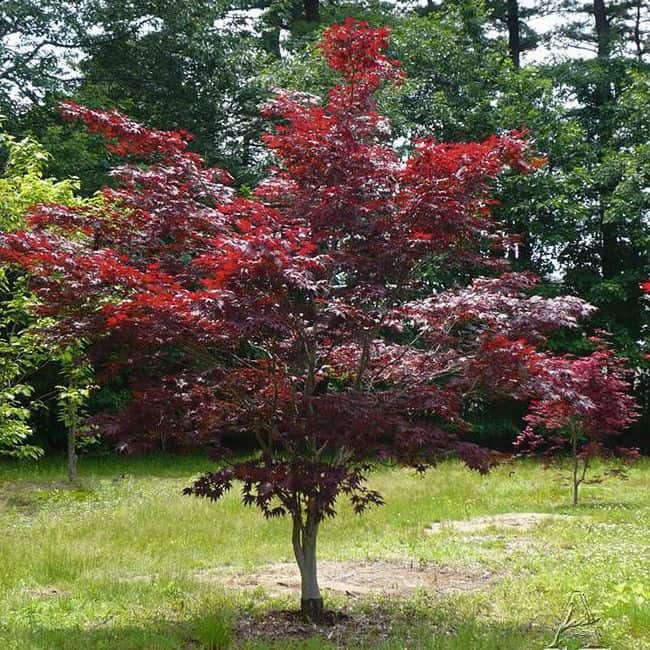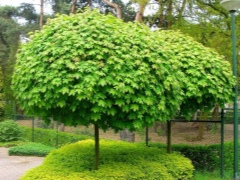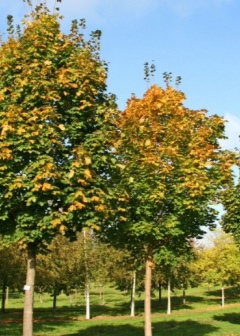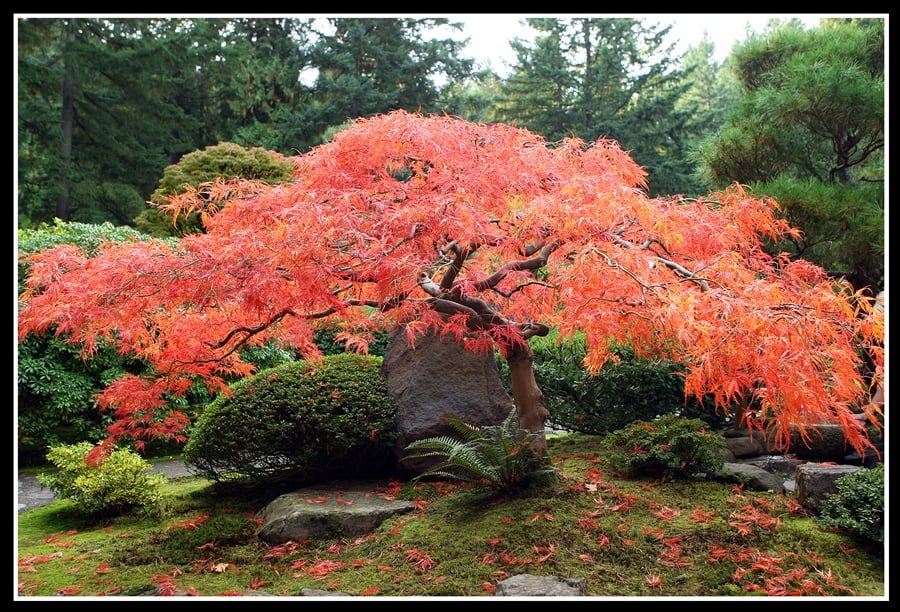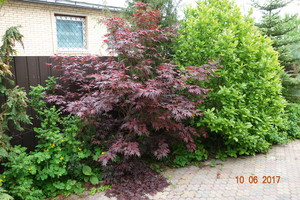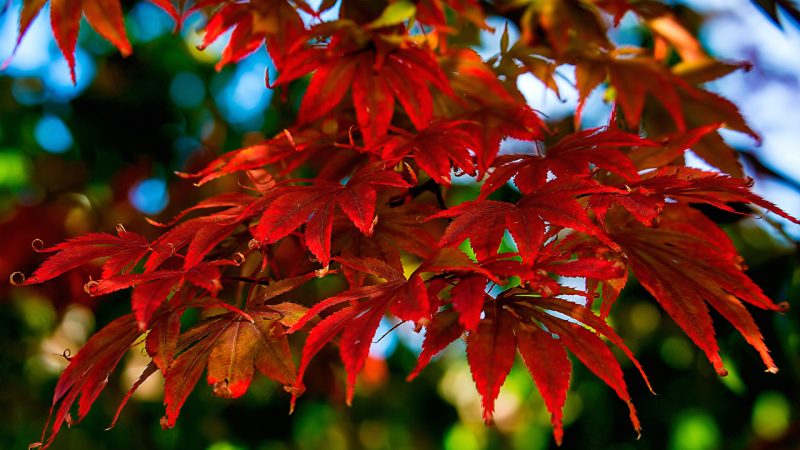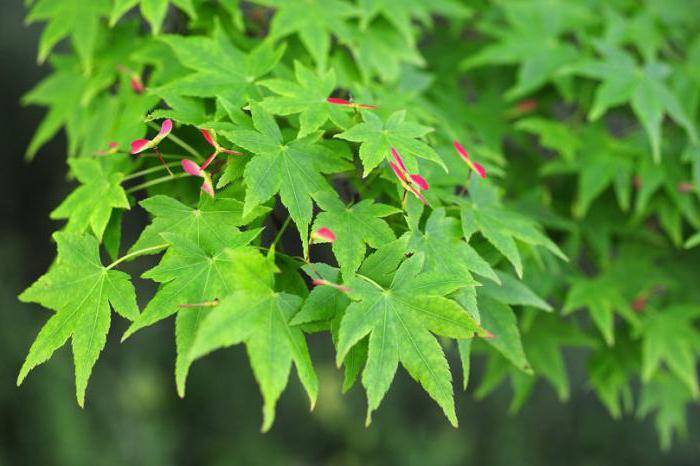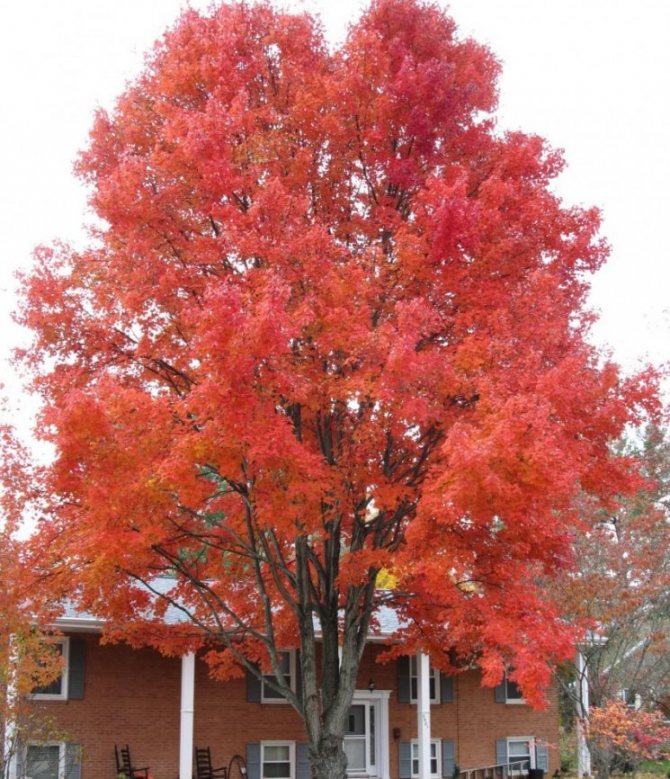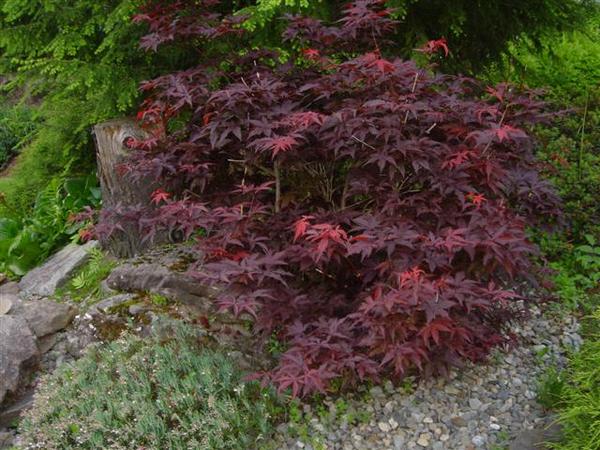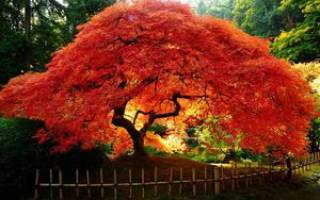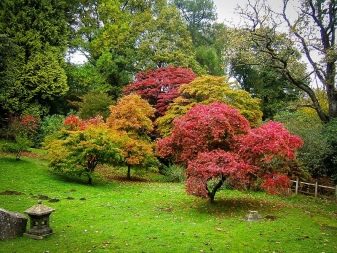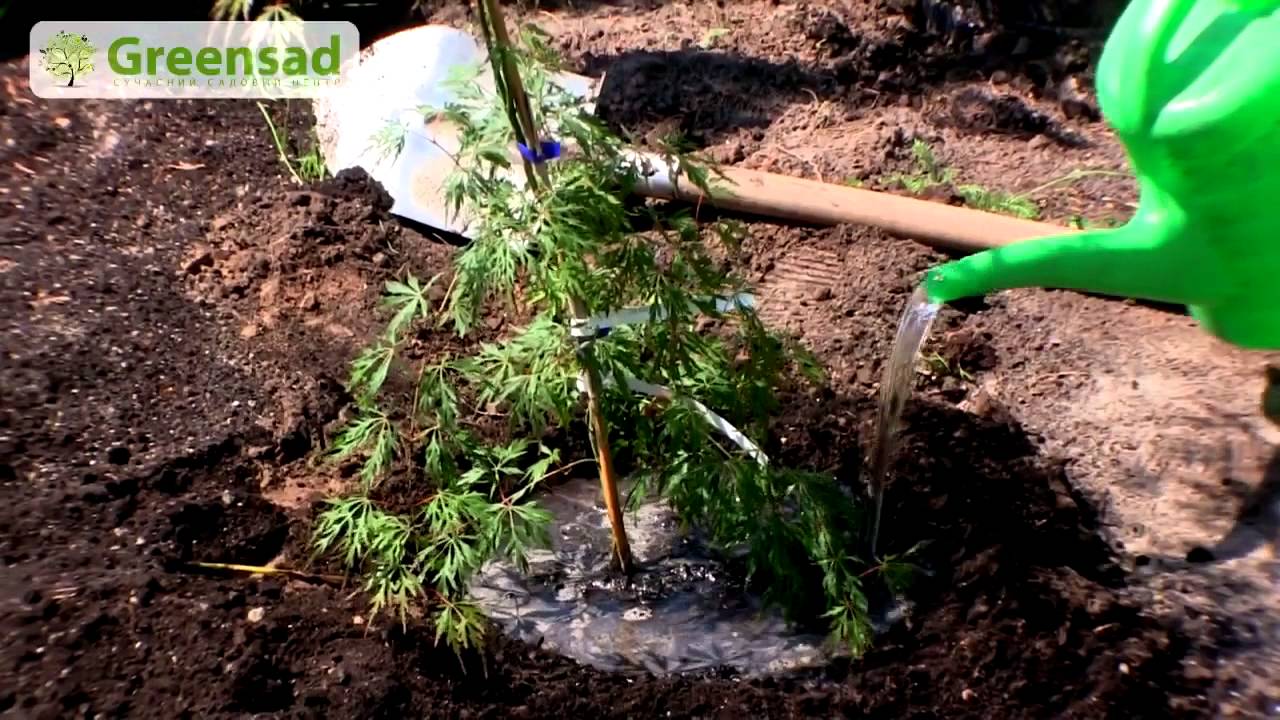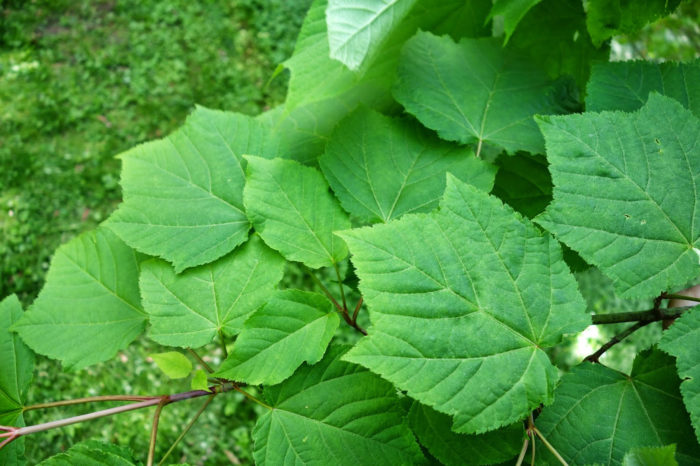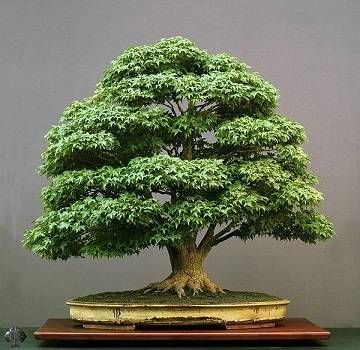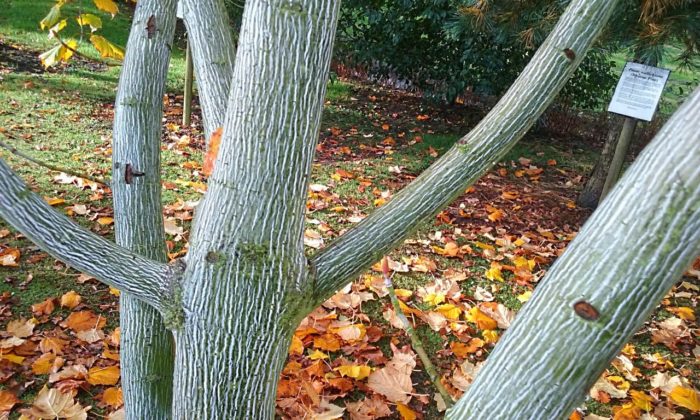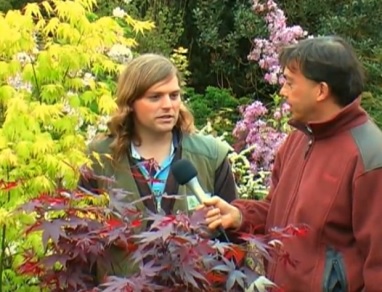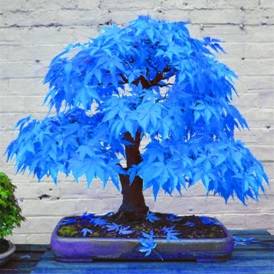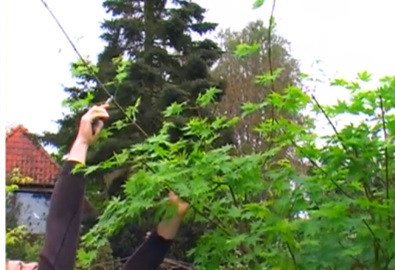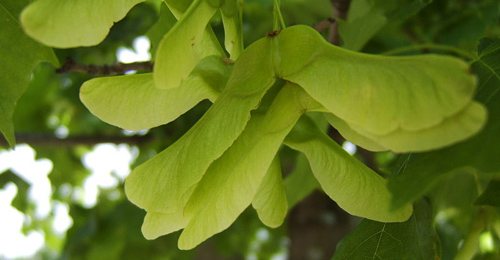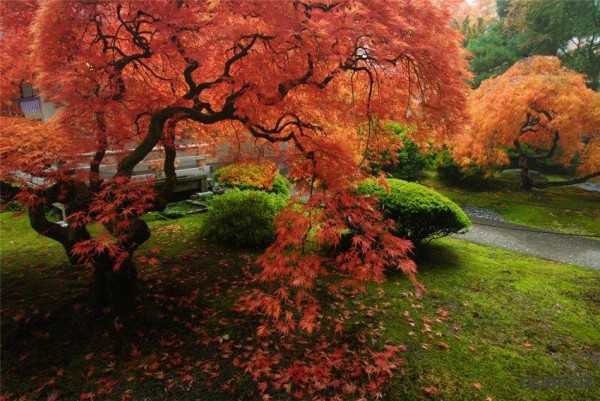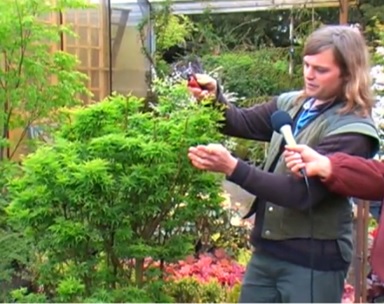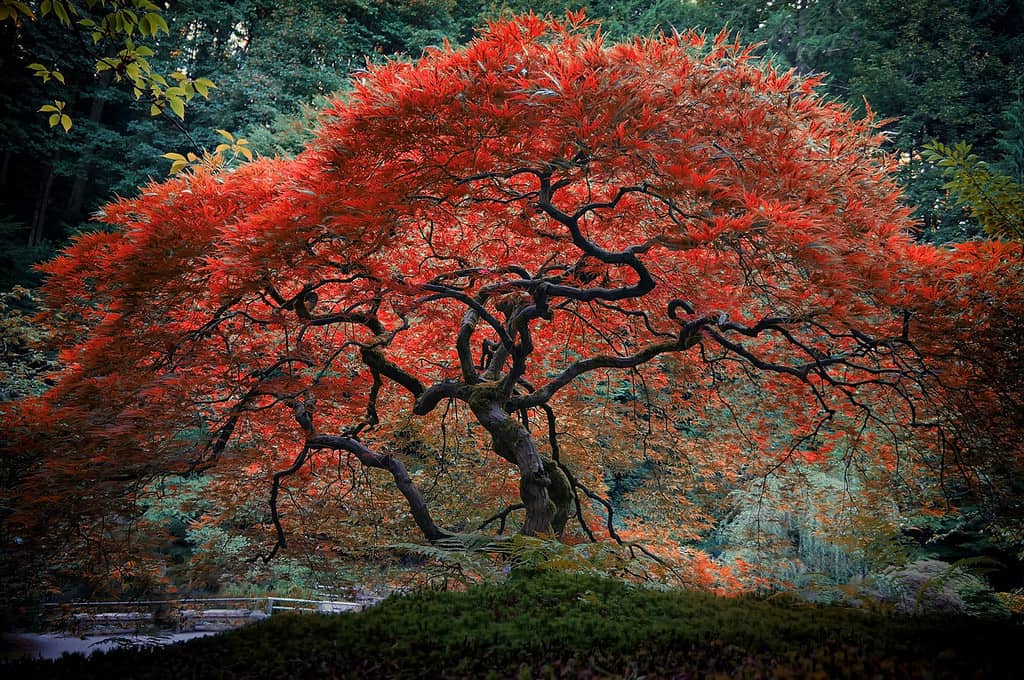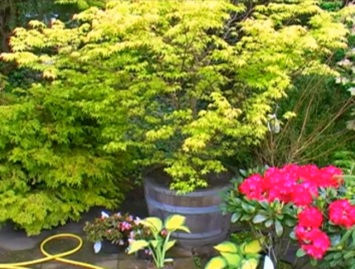Types and varieties
Maple classification is very complex. Taking into account the peculiarities of leaves, inflorescences and fruits, the structure of the wood, experts have identified 17 sections. We list several groups and species that can be recommended for growing in small gardens in central Russia.
Holly
It is worth mentioning separately about this European variety, since the most famous maple in our country belongs to her. This tree (Acer platanoides) grows up to 30 m and forms a spreading tent-like crown. The usual species representatives for limited areas, of course, will not work. But there are several suitable varieties.
- Crimson Centry features purple foliage and attractive, fragrant yellowish buds. The tree can grow up to 10 m, but the characteristic feature of the Crimson Sentry is the columnar shape of the crown, which is not more than 3 m in diameter.
- Columnare can also be up to 10 m high and has a compact columnar crown. The reddish tint of the leaves, which occurs when they bloom, subsequently disappears. The foliage is dark green.
- Globosum grows up to 7 m. Its peculiarity is a spherical crown. But in adult plants, it can acquire a flat shape, which can be corrected by pruning.
Far Eastern
In the Far East, maples grow everywhere, but they look different than European or North American ones.
One of the unpretentious and frost-resistant species is the Ginnala maple. These are small trees (up to 5 m) with a crown that has a wide conical shape. Maples of this species can also grow as multi-stem shrubs. Their deep-lobed leaves look especially beautiful in autumn, when they are painted in bright orange-red colors. The most interesting varieties:
- Durand Dwarf - dwarf, grows only up to 60 cm, leaves are small, highly branched;
- Albovariegatum - is distinguished by segmental white color of leaf plates;
- Pulverulentum - has white specks on the leaves.
By the beauty of foliage and grace, the undisputed leaders will be the palm-shaped or fan-shaped maples (A. palmatum), which are very popular in Japan. They grow slowly, in width even faster than in height, they do not grow higher than 3-4 m. But for cultivation in central Russia, they have a significant disadvantage - low frost resistance. It is believed that some varieties can withstand temperatures as low as -29 ° C, but in practice, above the snow level, the shoots are frozen over.
Japanese gardening enthusiasts often buy Dissectrum Atropurpureum, which has carved dark red leaves, and mature plants have almost purple leaves. For the winter, he needs a solid shelter. In the Moscow region, such maples are best grown as a tub culture. The pseudosibold maple (A. pseudosieboldianum) can serve as a good substitute for the whimsical palm-shaped maple. It is a slender tree up to 8 m high. It has bright green deeply dissected leaves on scarlet petioles.
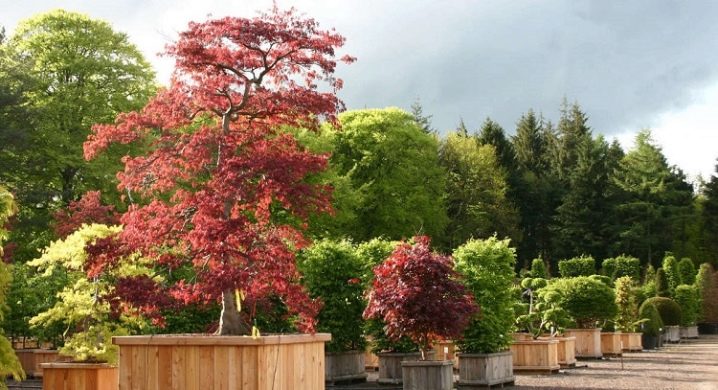
North American
The ash-leaved maple (A. negundo), which migrated to Russia from North America, is definitely known to everyone, because it has spread everywhere as a weed. It is curious that earlier it was grown in greenhouses. This species was introduced primarily because of its unpretentiousness, rapid growth and frost resistance. The decorative qualities of these maples are low, but there are also interesting varieties:
- Flamingo - a low (up to 4 m) tree or shrub, has variegated leaves, green with white-pink segments;
- Variegatum - grows up to 5 m, differs not only in decorative white-green leaves, but also in interesting large fruits.
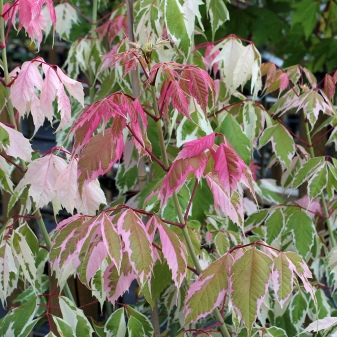
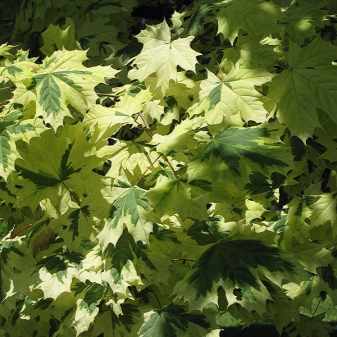
Shrub
Some maple species can form multiple trunks and appear as large shrubs. In addition to ash-leaved, pseudosibold and riverine, these include the bearded (A. barbinerve) with a spectacular violet-red bark, having large flowers curled maple (A. circinatum) and Tatar (A. tatarucum), characterized by fragrant white inflorescences. The main advantage of shrub species is that they tolerate pruning well.
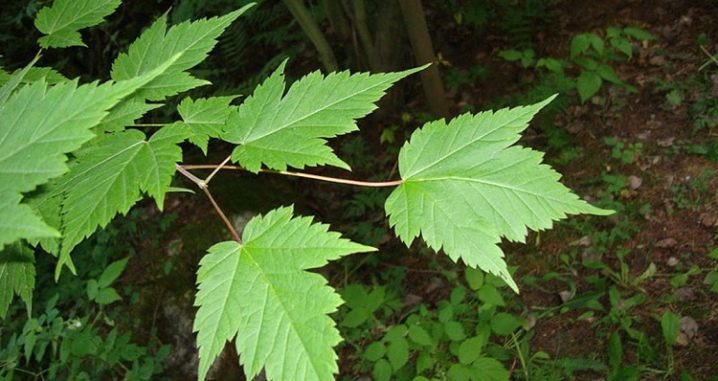
Landing right in the ground
This method has its drawbacks, it is likely that the seeds will hatch only in the second year after planting, and in winter they may die during severe frost or lack of snow cover.
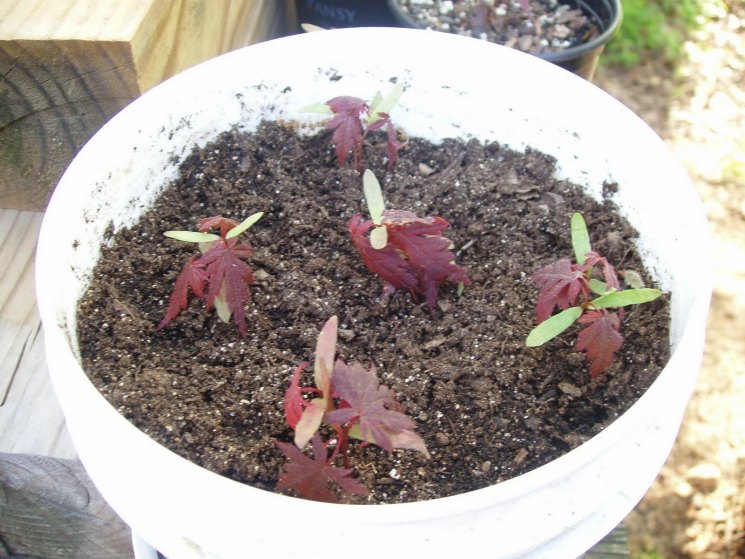
Seeds are planted in pre-prepared soil in late autumn, shortly before snow falls.
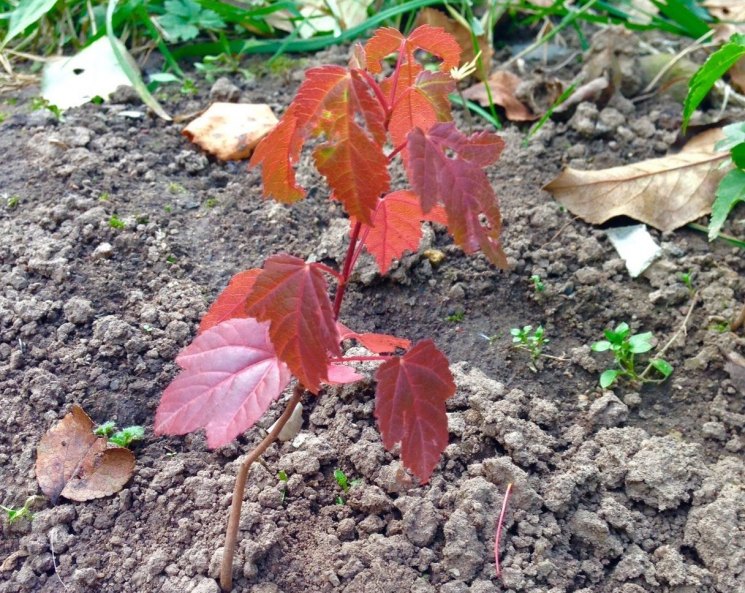
How to plant a maple on the site: the soil must first be dug up and loosened. We dig a hole (depth about 70 cm, width 50 cm), add a mixture of sand, humus or peat compost with turf soil in a ratio of 3: 2: 1. A small amount of mineral fertilizers and drainage can be added to the bottom of the pit.
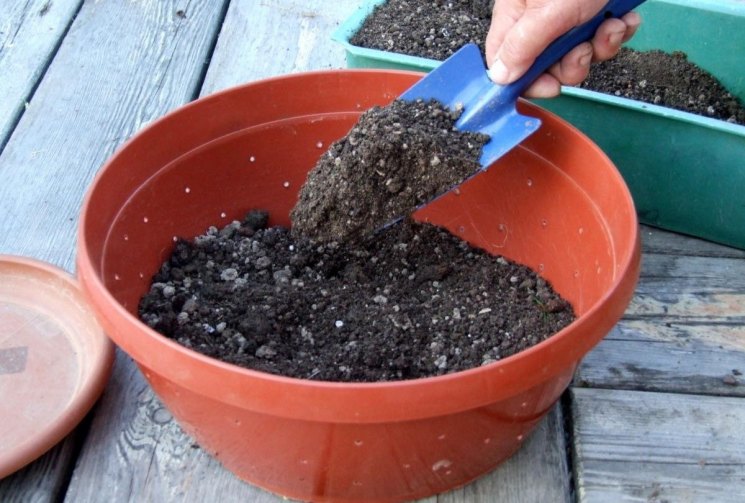
The seeds are placed at a depth of 4 cm with their wings up. The ideal planting site would be a sunny area or some shade. It should be borne in mind that plants with unusual leaf color may lose color when planted in the shade.

Before planting a maple, it is important to remember that the distance from the plant to the buildings should not be less than 5 m.

Varieties
We list the most interesting types of red maple that adorn houses, gardens and parks.
- Sun Valley is a dwarf (no more than 7 m) and slow-growing tree. In early spring, scarlet inflorescences bloom. The crown is symmetrical, in the form of an oval. In autumn, the leaves change from green to purplish red and become shiny. Loves light, is not afraid of drought and frost.
- Otom Flame is a medium tree (up to 14-15 m in height), originally from America. The crown has a spherical shape and spreads up to 15 m wide. In autumn, the leaves remain red for a long time with orange splashes. Ideal for creating alleys.
- "Oktober Glory" is a striking representative of red maples. It grows up to 15 m, but rarely. The branching of the crown is uniform, in the form of a pyramid. The foliage is green with a glossy shade, and with the onset of cold weather it acquires a pink-red color. Dislikes heat and drought.
- Red Sunset is a popular variety originating in the United States. Reaches 18 m in height. The bark is a very pleasant gray color. The leaves are larger than those of other species, fall late and turn bright red against the backdrop of snow-covered parks. The tree loves light and is not afraid of even severe frosts.
- "Royal Red" is a holly tree, the average height is 15 m. In May, yellowish flowers bloom. The crown is pyramid-shaped and heterogeneous. In the summer season, the leaves are brown, purple in color, and turn red in the fall. Looks perfect against the background of coniferous trees.
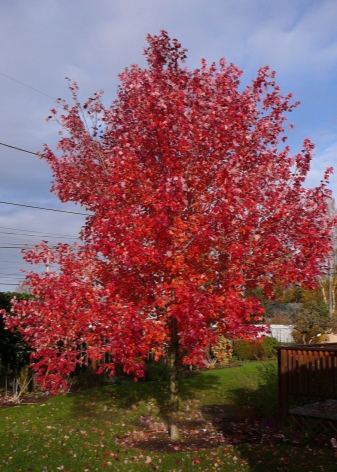
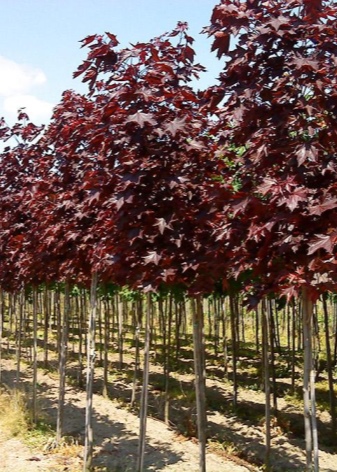
- "Brandywine" - a small tree up to 9 m in height, the crown has an oval shape. In the autumn, green leaves gradually change color to orange, then turn red and do not fly around for a long time. It tolerates moisture well.
- In Japan, a dwarf palm-leaved maple grows, its height rarely exceeds 2 m. The crown is asymmetric. The leaves are fan-shaped - red in summer and purple in autumn. Some craftsmen grow trees with blue foliage using the bonsai technique. Japanese maples are very decorative and do not survive in severe or prolonged frosts.
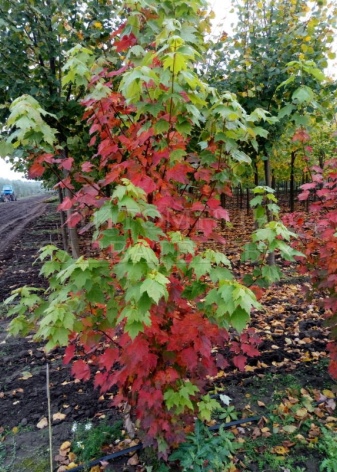
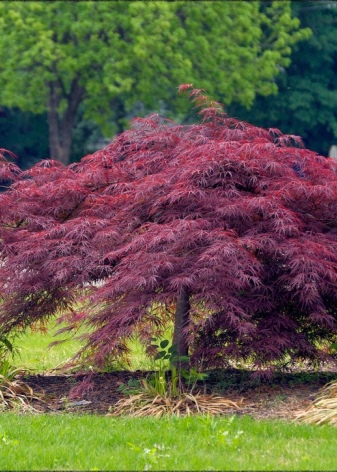
How to calculate the number of seedlings?
There are certain rules for planting trees in a personal plot. For example, trees should not be located too close to neighboring fences and power lines. Usually, seedlings are placed at a distance of 5-6 meters. Between plantings, certain gaps must also be observed so that the growing trees do not shade each other.
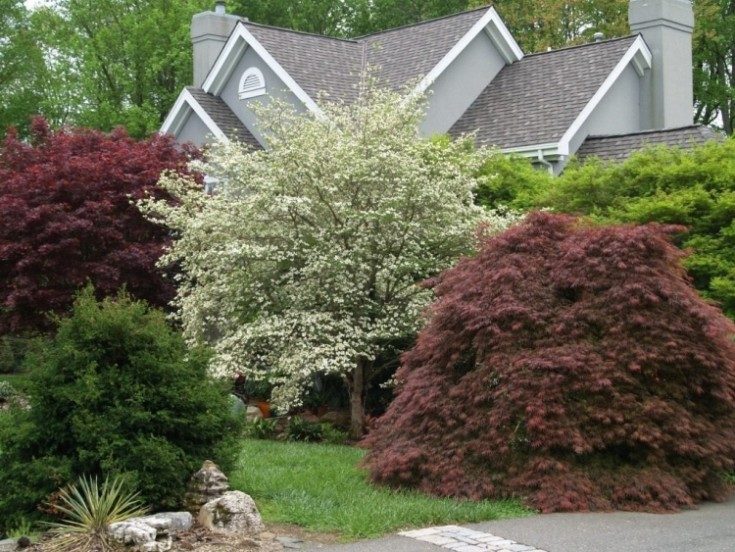
On average, the distance between trees and shrubs in an orchard should be something like this: large fruit trees for the garden (apples, pears, apricots, cherries) are planted after 5-6 meters, the distance between rows should be slightly larger - about 8 meters for unhindered transportation carts and other garden work.
While the trees are small, separate beds with vegetable or berry crops can be broken between them. As the beds grow, they will have to be transferred to another place.
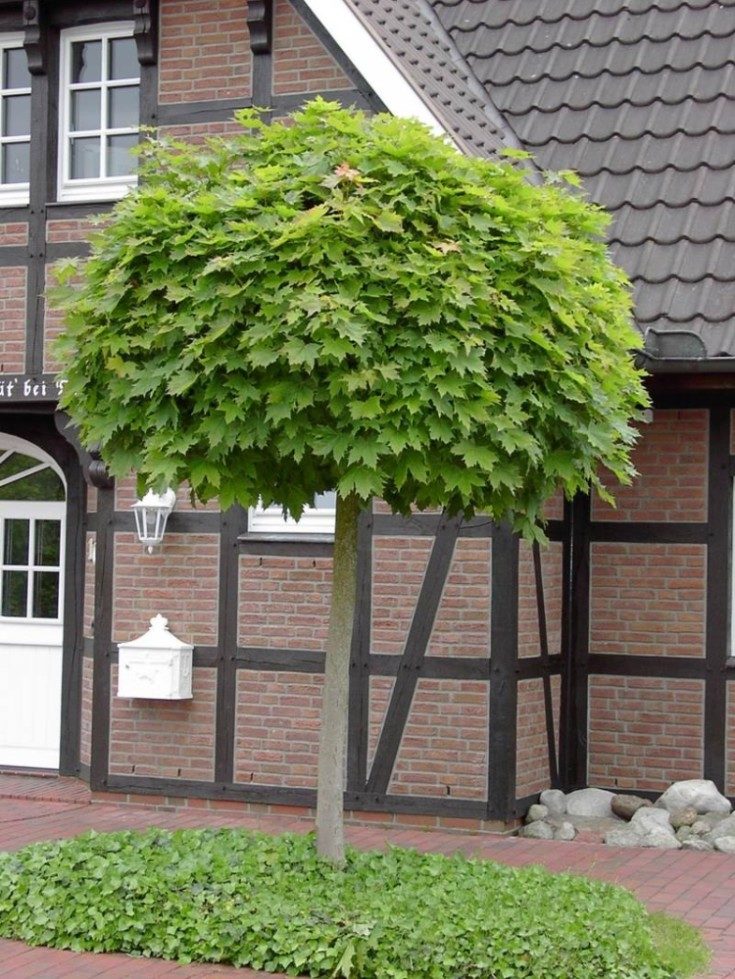
The most beautiful trees for landscape design
Modern species and varieties of quite common plants can become an alternative to expensive introduced species.The most beautiful ornamental trees can give the garden an exotic look:
Birch Royal Frost.
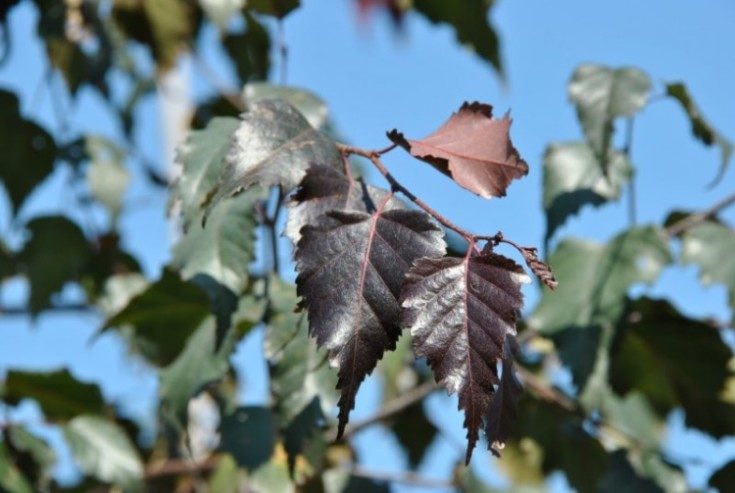
An unpretentious, but outwardly spectacular variety of drooping birch with dark red foliage. The seedlings have a bronze shade of the bark, but with age it turns white, and the decorativeness of the plant increases.
Maple Atropurpureum.
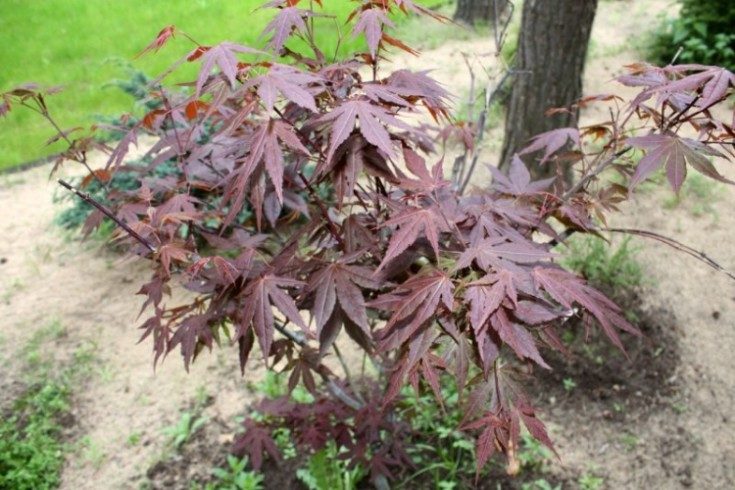
Unusual variety with an umbrella crown and scarlet color of the leaves. The flowers also have a purple hue. It goes well with conifers, creating a bright spot of color against their background.
Acacia tree Pendula.
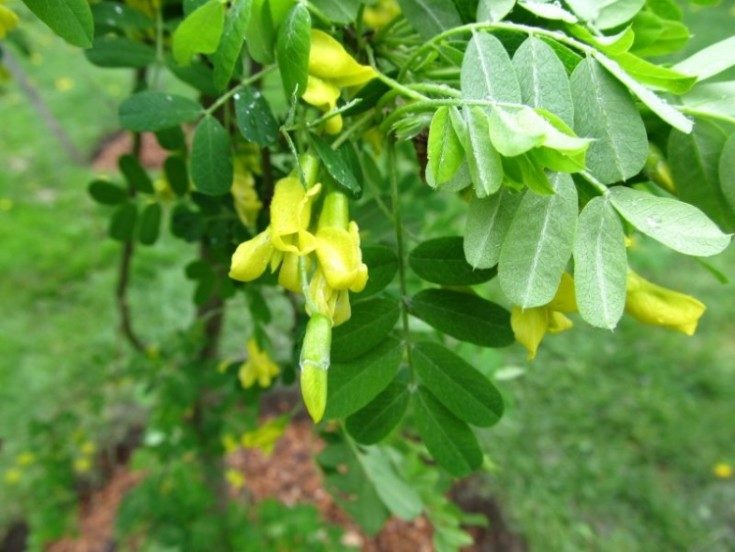
Weeping form with graceful long shoots. Possesses decorative foliage, blooms with yellow fragrant flowers. It tolerates frost, drought and haircuts well.
Rowan tree Kirsten Pink.
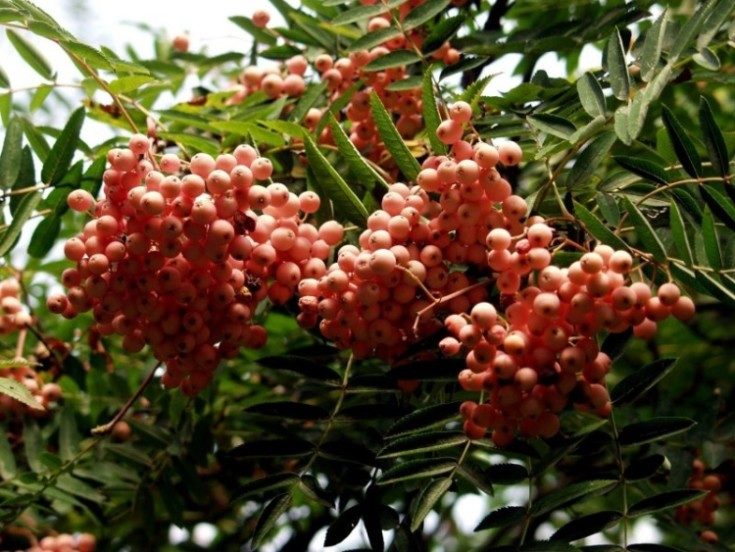
A frost-resistant, multi-stemmed tree with slow growth and highly decorative openwork crown. Especially effective during flowering and fruiting. Fruits of unusual pink color.
Cherry fine-sawed Amanogawa (Prunus serrula Amanogawa)

One of these is the cultivated form of the finely sawed Amanogawa cherry. This tree has a dense columnar crown up to 2 m wide and grows up to 4-7 m in height. In the spring, beautiful clusters of double, pale pink flowers appear on it. Amanogawa does not bear fruit, so you will hardly be able to enjoy the fruits of ripe cherries.
For planting this cherry, sunny places protected from the cold wind with fertile, moderately moist soil are suitable. Amanogawa is afraid of severe frosts, therefore it is recommended for cultivation in regions not north of the sixth climatic zone (from –23 to –18 ° С).
Hawthorn (Crataegus)
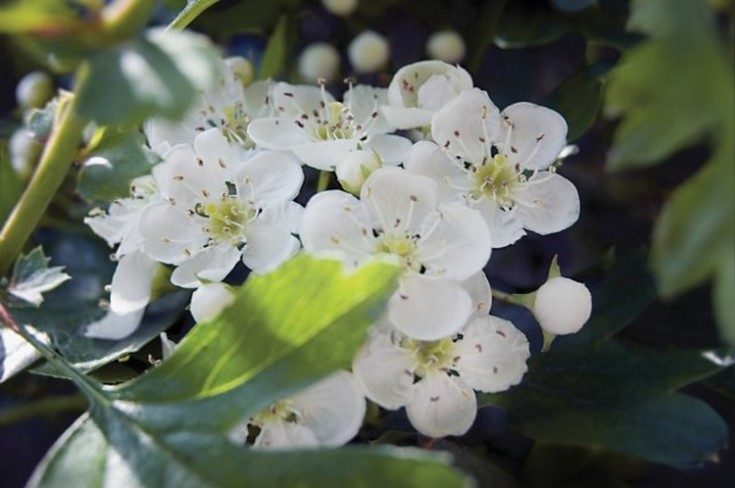
Scarlet hawthorn can be found in many gardens. It usually grows up to 6 m in height (very rarely up to 12 m). The popular names for this plant are "glod", "boyarka" or "lady".
Due to its low growth, this plant is ideal for small areas. Often, with the help of hawthorn, hedges are arranged: they not only look amazing, but will also become a reliable protection for the site.
Flowers with a diameter of 12-15 mm, connected in lush inflorescences, are painted in golden-white color. Hawthorn fruits - medium-sized berries of bright red or orange color with powdery pulp are used in medicine, as well as as a vitamin supplement for poultry.
Cercis canadensis (Cercis canadensis)

One of the most beautiful spring trees, which does not exceed 8 m in height, is the canadian cercis, or “forest pansies”. It is beautiful in early spring, mesmerizing with its flowering. In the southern regions it grows like a shrub.
Usually, growing and caring for Canadian cercis outdoors is not difficult, but it is important to choose the right variety. Although the places that begin north of the Voronezh region are no longer suitable for its cultivation: it will freeze and will not bloom
The climate of the Moscow region is also not suitable for cercis - it, of course, will not die, but it will not please with luxurious flowers either.
Although the places that begin north of the Voronezh region are no longer suitable for growing it: it will freeze slightly and will not bloom. The climate of the Moscow region is also not suitable for cercis - it, of course, will not die, but it will not please with luxurious flowers either.
Maple gray (Acer griseum)
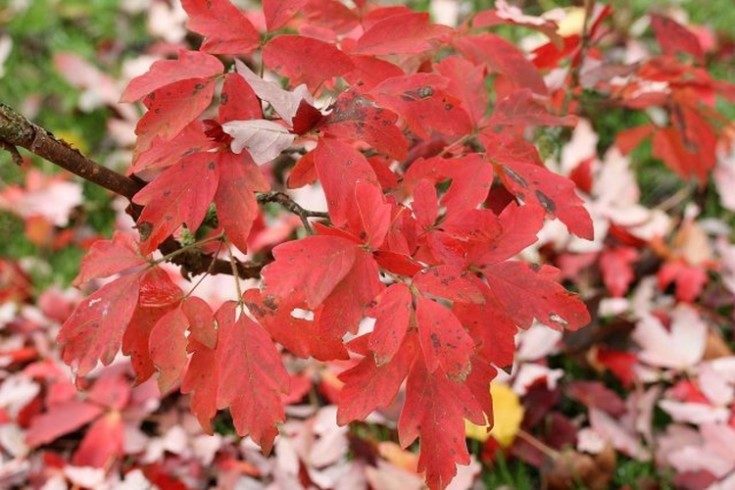
This distinctive feature allows the tree in winter - against the background of the winter sky and snow-covered ground - to look much more interesting than in the warm season.
It grows in height up to 6-10 m, and its crown can reach 7.5 m in diameter. This tree is not afraid of even very severe frosts - it can withstand frosts down to -45 ° C. However, if your garden is very modest in size, it is better to refuse to plant this plant.
Bonsai oak: description, planting and care
How to grow bonsai oak? Indoor oak looks great in the interior, in addition, it can be grown from an acorn or a ready-made seedling
If you chose the first method, then it is important to choose high-quality planting material - acorns should not be rotten, with mold. We place them in moss or sand and put them in the refrigerator for 2 months
Keep an eye on the moisture level - excess moisture will kill the acorn! For further planting, we choose and compose a dense soil - clay and fallen dry leaves in a ratio of about 9 to 1. You can put moss on the surface of the pot, which will slow down the evaporation of moisture from the soil. But before wintering, the surface of the earth is covered with dry leaves - they will prevent the roots from hypothermia.
In summer, the plant is often watered, in winter, during the dormant period, the frequency of watering is reduced to 1 time per week. Remember that bonsai oak adores warm and humid climates, so a sunny spot and frequent watering are essential for its growth.
Planting care
Seedlings obtained from seeds are pruned at the age of 3 months - the main stem is shortened by 2/3.
Blue, blue red maples develop in the same way as green ones: each species should be transplanted in the spring with an interval of no more than 2 years. Each time the soil is completely changed, the central and lateral roots are pruned by 20%.

The shoots are pinched after the formation of 2-4 leaves.
When the plant reaches a height of 10 cm, it is transplanted into an ordinary pot, preferably a ceramic one.
In late spring and early summer, bonsai are fertilized with special dressings.
Maples love shade, so you shouldn't leave them in the sun. It is also impossible to expose the composition to large temperature extremes.
Crown formation
Maples are given different shapes by pruning branches and the direction of their growth.

The blue maple in the photo is obtained from seeds. When a new branch appears in a grown plant, it is wrapped with a thin wire at the base and fixed to the pot in the desired direction. Thus, the most bizarre and exotic forms of dwarf trees are obtained.
You can grow a home bonsai with your own hands in 5-7 years with proper timely care.
Maple bonsai: how to grow
Location
Maple trees are hardy and adaptable. Although this plant looks small and cute, maple bonsai should not be called a house plant. This is a wild tree in miniature form.

Exposure to sunlight is one of the most important factors when deciding where to place your Japanese mahogany. In the morning, it is necessary for the tree to receive sufficient sunlight.
During a hot summer day, the tree should be protected from direct sunlight. Strong heating leads to the formation of dissolved minerals in the leaves, which causes them to change their color to cinnamon.
The delicate foliage of the palmate maple is prone to drying out at the edges when exposed to too much sun. Drying is more pronounced at the edges. The effect of direct sunlight is not just limited to the leaves. Even the roots
can be dried and the results are seen in the falling foliage of the bonsai.
Harsh winds can be devastating to your blue ooze of red bonsai. The foliage of unprotected trees can be damaged by strong winds.
Cold protection
Trees are rooted deep in the ground, which protects them from freezing.

For bonsai, the immersion is not so deep that it poses a huge threat to the root system. Temperatures up to 5 degrees are tolerable, but anything below this is harmful.
Care and watering blue maple
Although they adapt very well to bonsai, care should be taken when it comes to watering. The wrong methods will kill your tree more than any other problem
Blue maple thrives in moist and damp soil.
As a rule, one watering a day is sufficient, but on hot days you can do this twice a day.
Like most Japanese maples, Miniature Bonsai prefers neutral to slightly acidic water. In this case, the use of lipid water should be avoided.
Pruning branches
To form your bonsai, you need to trim certain parts of the crown.You can prune new shoots and small twigs throughout the year. Pruning of mature branches should be carried out in the fall or summer, when the tree is most capable of masking its wound with callus. Spring pruning results in excessive juice bleeding.
To avoid fungal attacks, which tend to penetrate the tree through pearlescent wounds, it is recommended to apply cut paste.
The root system also needs pruning when transplanting plants.
Transfer
The blue maple bonsai is best transplanted in the spring when it is actively growing. This should be done once a year for young trees and every three years for older plants.

With each repotting, the roots should be trimmed sufficiently. The root system recovers quickly and fills the pot in a short time. Blue maple root pruning should be accompanied by branch pruning to balance water and nutrient intake with higher intake. It is necessary to remove dead roots to prevent others from rotting.
Planting and leaving
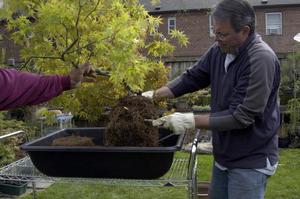 Japanese maple trees in their natural habitat, at home, usually grow in the undergrowth, respectively, for a normal life and normal plant growth, appropriate conditions must be created.
Japanese maple trees in their natural habitat, at home, usually grow in the undergrowth, respectively, for a normal life and normal plant growth, appropriate conditions must be created.
The soil should be sufficiently generous and sufficiently fertilized. By no means do Japanese maples like stagnant water. Therefore, in the garden where it grows, it is imperative to make drainage, because stagnant water can harm the root system.
The variegated color of maple leaves suggests that they love sunny places, so this fact must be taken into account when planting. In our conditions, Japanese maple trees suffer most from late spring frosts. Even when the leaves have blossomed, but suddenly frost has come, the Japanese guest may suffer.
Speaking about whether it is possible to grow Japanese crops in our conditions with rather harsh winters, it is worth noting that some varieties can withstand temperatures down to minus 20 degrees. If there is an assumption that the temperature will drop lower in winter, then you need to try to make a shelter for the tree. This is not difficult, because if a low variety is grown, with a height of 2-3 meters, then a frame is made, and a special warming fabric is pulled over it.
A very important point in caring for Japanese crops is timely mulching. The mulch is usually applied twice in the spring and autumn before the onset of winter. Spring mulching has its own characteristics. The fact is that before you lay the mulch in the trunk circle, you first need to apply some kind of slow-acting fertilizer. Then cover it all with a layer of peat and cover it on top with a layer of any mulch.
It is necessary to fertilize the tree once a month in the spring. For this, a mixture of fertilizers is laid out on the surface of the trunk circle, and a layer of 5 cm of compost is poured on top. Fertilizers are last applied at the beginning of July.
Do not use high-concentration high-speed nitrogen fertilizers. The fact is that the Japanese maple does not like this.
Trees grown under normal conditions practically do not get sick and are not affected by pests.
Selection of seedlings
Since Japanese maple seedlings are very expensive, their choice must be taken responsibly and carefully. First of all, it is worth deciding on the variety of the Japanese plant. If there is a large area for growing a tree, then large varieties can be selected. If the territory is limited, then it is recommended to select a decorative dwarf maple for growing.
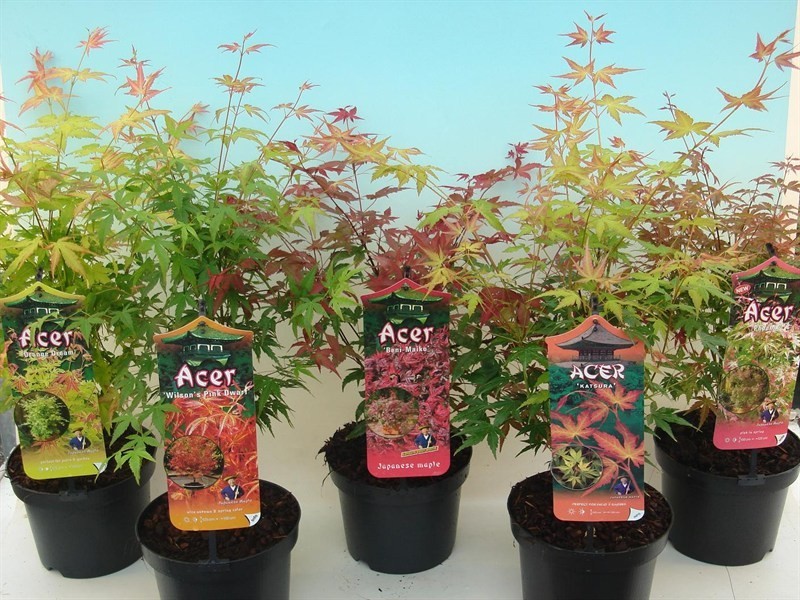
It is best to purchase a seedling in a container, as in this case planting and caring for the red Japanese maple will be much easier and safer.In addition, the likelihood that the seedling will take root better increases, since it will grow in its native soil, and the root system will not suffer during planting. The ideal age of a seedling for planting outdoors is up to 1 year. You need to purchase a young tree in a specialized store. Outwardly, the maple should look fresh and healthy, it should not have dull and withered leaves or any damage.
Melon tree: rules for growing papaya from seeds
The need for pruning
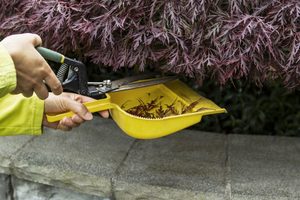 Pruning of Japanese maples, in principle, is not done. They form a very beautiful crown themselves. But if you suddenly wanted to correct this shape somewhere, then you can cut the tree a little. The Japanese tree is pruned mainly in early spring, before the start of sap flow, before the leaves begin to bloom.
Pruning of Japanese maples, in principle, is not done. They form a very beautiful crown themselves. But if you suddenly wanted to correct this shape somewhere, then you can cut the tree a little. The Japanese tree is pruned mainly in early spring, before the start of sap flow, before the leaves begin to bloom.
Sometimes it is recommended to thin out the crown in order to preserve all the boundaries of parallelism and so that the sun illuminates the depth of the crown well. To do this, some branches inside the tree can be removed.
The main advantages of having dwarf ornamental trees on the site
There is an unspoken rule that dwarf trees are not just a whim of the owners, but a purposeful task that is posed and dictated by the trend of the present time for compact plants. Of course, the first is the aesthetic value. It is difficult to argue with the beauty of compact and very beautiful plants, especially if the planting took place not in a chaotic, but in a clearly planned form, observing all the recommendations and rules. Secondly, the compactness of the dwarf representatives helps to create an illusion. So, visually expand a narrow section, and from a small one make the appearance of a large one. It is dwarf trees that, without harming the overall picture, will be able to significantly strengthen talus and sloped areas. Decorating structures, buildings and creating full-fledged zones with clear boundaries is the strong point of dwarf trees. If on your site there is not only a recreation and comfort zone, but also a full-fledged area with vegetable crops, then just ornamental trees will be able to create a smooth transition between plantings. Well, a more practical option for use is a hedge, which will become a natural option for a fence, as well as a good barrier from the prying eyes of neighbors and passers-by.
In addition to the value of such plants on the site, it is worth noting the strengths of the direct structure of each decorative bonsai. These are modest sizes, which have different indicators, but often do not exceed the 3-meter mark. The crown has an attractive, non-standard shape, the foliage is often very beautiful, so the decorative value is preserved throughout the season. The contrast is most often the trunk itself with its bright bark, as this is what makes the real contrast and beauty of the combination. If a tree is not just decorative, but also capable of surprising with magnificent flowering, then it is difficult to take your eyes off such a tree.


